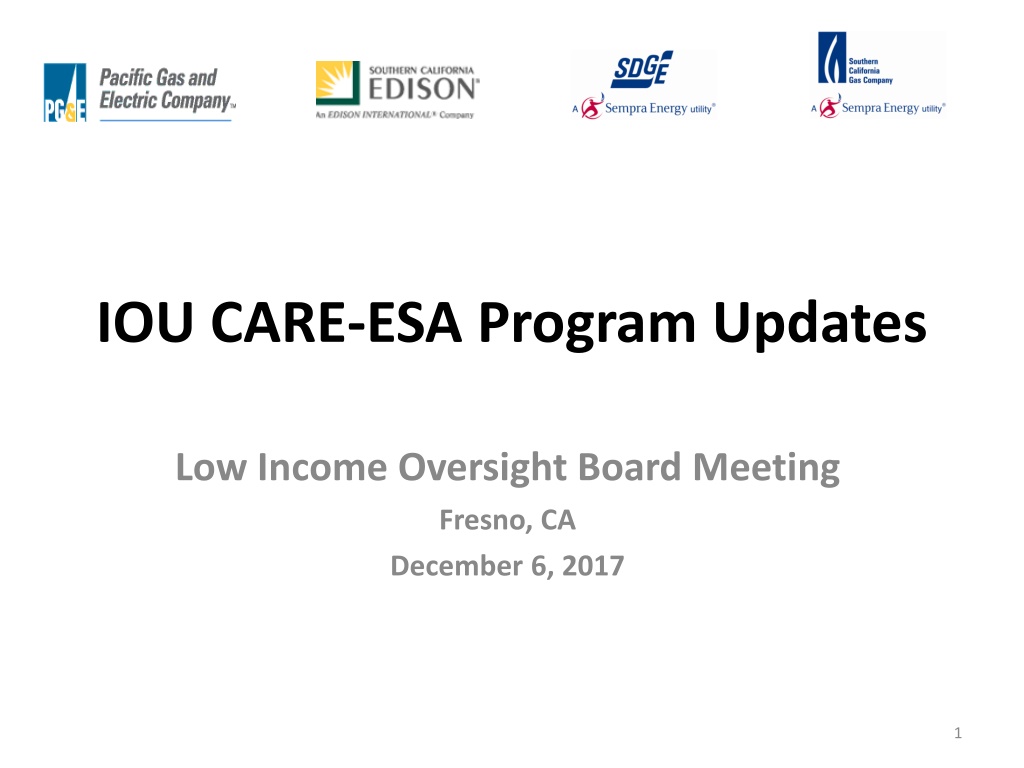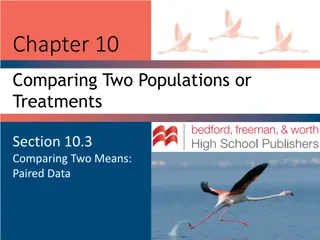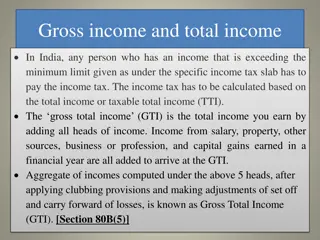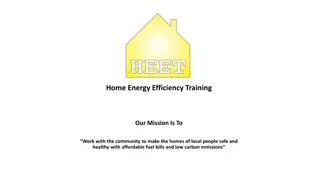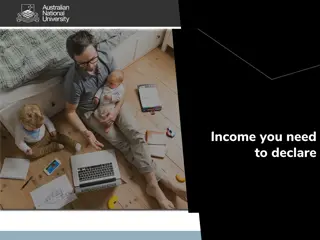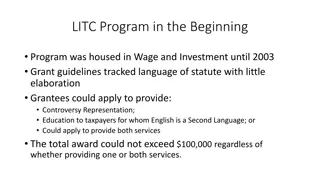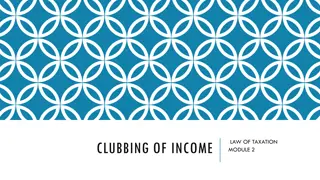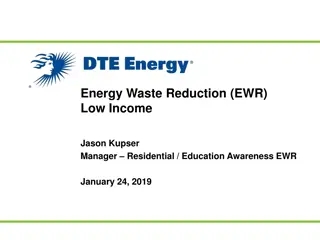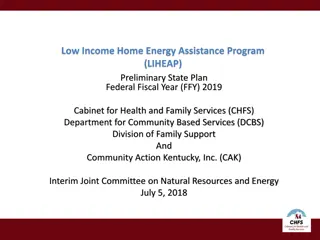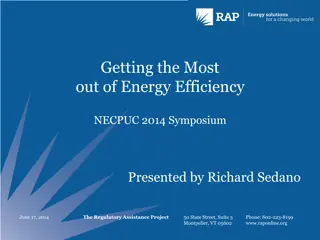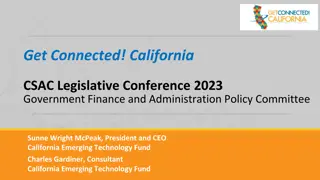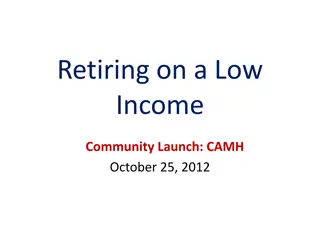Energy Efficiency Services Program Updates for Low-Income Households
The Energy Savings Assistance Program in California provides energy efficiency services to qualifying low-income households, such as weather stripping, insulation, and appliance upgrades to help manage energy bills. Updates include progress with federally-recognized tribes, ongoing outreach initiatives, budget allocations, and enrollment figures for the CARE Program. The efforts aim to assist communities in better managing their energy consumption and costs.
Download Presentation

Please find below an Image/Link to download the presentation.
The content on the website is provided AS IS for your information and personal use only. It may not be sold, licensed, or shared on other websites without obtaining consent from the author. Download presentation by click this link. If you encounter any issues during the download, it is possible that the publisher has removed the file from their server.
E N D
Presentation Transcript
sce_logo IOU CARE-ESA Program Updates Low Income Oversight Board Meeting Fresno, CA December 6, 2017 1
Energy Savings Assistance Program PU Code Section 2790 requires the CPUC to provide energy efficiency services to qualifying low-income households. This program provides energy efficiency services such as weather stripping, insulation, and appliance upgrades to help these Californians better manage their energy bills. Tribal Activities 2017 YTD* Program Updates Federally- Recognized Tribes IOU Recent Activity ESA Authorized ESA Program 2017 Budgets and YTD Expenditures Completed initial CARE-ESA penetration assessments of eligible customer households on tribal lands. Continuing work to design comprehensive contact strategies and integrated program offering. Meetings with Big Sandy Rancheria. Discussions with CSD re potential leveraging outreach and projects. Continue to work with SCE Tribal liason to engage the various tribes in the service territory. Note: Pechanga Band of Luiseno Indians is no longer considered within SCE service territory. Continuing work with IOUs. Meetings planned for Q4 include local tribal organizations such as LA City/LA County Native American Indian Commission, American Indian Community Council and Southern California Indian Center as well as local events. Outreach to tribal populations in partnership with tribal organizations continue. The outreach team participated at a Southern Indian Health Council Wellness Conference on 10/26/17. 2017 Budget YTD Expenditures % Unspent Funding ** PG&E $152,928,421 $99,227,879 65 $183,079,952 SCE $62,375,617 $49,771,933 80 $124,000,000 PG&E 51 SDG&E $30,649,505 $13,360,126 44 $23,322,672 SoCalGas $126,782,639 $55,063,723 43 $239,553,201 SCE 12 Total $372,736,182 $217,423,661 $569,955,825 SoCalGas 20 2017 YTD ESA Households Treated 2017 Goal First Touch 90,030 42,460 54,509 47,055 20,316 11,028 110,000 27,454 274,855 127,997 Go-Backs 25,219 19,865 1,739 40,894 87,717 Total 67,679 66,920 12,767 68,348 215,714 SDG&E Total 19 102 PG&E SCE SDG&E SoCalGas Total 2017 MULTIFAMILY UPDATES SPOC: All IOUs have some SPOC facilitation at this time. Common Areas: IOUs have provided proposed approaches to the MFWG for implementation of common area measures for MF, and expect to file implementation plans for inclusion of common area measures in 1st Qtr 2018. 2017 YTD ESA Annual Savings ESA KWh 21,058,020 22,403,725 2,428,954 SoCalGas N/A TOTAL SW PARTICIPATION IN 2017 BY TYPE Mobile Home 7% 2017 ESA PROGRAM UPDATES Utility PG&E SCE SDG&E ESA KW 21,513 3,569 266 N/A ESA Therms 700,778 N/A 139,973 1,055,098 1,055,098 Go-Backs: sce_logo See chart Energy Education: IOUs working together on training and collateral materials Multi- family 25% * 2017 YTD: Through October 31, 2017, reported in IOU ESA-CARE Monthly Reports (November 21, 2017) ** Unspent Funding: Does not include funding committed in IOU Conforming AL budgets, submitted April 3, 2017 Single Family 67% 2
CARE Program PU Code Section 739.1(a) requires the CPUC to establish a program of assistance to low-income electric and gas customers with annual household incomes that are no greater than 200 percent of the federal poverty guideline levels. 2017 YTD* Program Updates Authorized 2017 CARE Program Budgets and YTD Expenditures 2017 Budget YTD Expenditures $18,060,001 $10,990,956 $6,424,661 $4,527,169 SDG&E $6,911,207 $4,462,945 SoCalGas $8,938,505 $6,892,400 Total $40,334,374 $26,873,470 % YTD Rate Discounts $552,334,023 $325,700,656 $96,156,401 $89,503,076 $1,063,694,156 PG&E SCE 61% 70% 65% 77% 2017 YTD CARE Enrollment and Penetration Customers Enrolled PG&E 1,406,909 SCE 1,227,268 SDG&E 282,388 SoCalGas 1,557,184 Estimated Eligible 1,588,016 1,457,787 329,763 1,819,451 Penetration Rate 89% 84% 86% 86% sce_logo 2017 YTD CARE New Enrollments Newly Enrolled 221,505 244,704 60,189 218,659 PG&E SCE SDG&E SoCalGas * 2017 YTD: Through October 31, 2017, reported in IOU ESA-CARE Monthly Reports (November 21, 2017) 3
SoCalGas ESA Intensified Efforts for Aliso Canyon Emergency Following the issuance of D.16-04-040, a total of 75,578 homes were treated within the designated area through October, 2017. Treated w/o rule suspension: Treated with rule suspension: Therms saved w/o rule suspension: Therms saved with rule suspension: 32,588 42,990 436,185 509,052 4
Southern California Edison ESA Intensified Efforts for Aliso Canyon Emergency Following the issuance of D.16-04-040, a total of 115,399 homes were treated within the designated area through October, 2017. Treated w/o rule suspension: Treated with rule suspension: kWh saved: kW saved: 28,597,868 38,934 76,465 4,380 sce_logo 5
SoCalGas Solar Water Heating Program Part of the California Solar Initiative (CSI) Thermal program, SoCalGas offers solar water heating rebates of up to $4,366 ($5,397 for low income) to single-family homeowners, up to $800,000 to multi-family and commercial businesses, and up to $500,000 for solar pool heating systems for commercial and multi-family properties. SoCalGas processed to date 493 single family low income applications, total of $2.2M in incentives and equating to 64,123 in annual therms saved. Approximately 900 applications pending for review. For SoCalGas Multi Family Low Income customers, processed 376 applications, total of $2.4 M in incentives and equating to 602,898 therms saved. 6
SDG&E Low Income Solar Offerings Multi-Family Affordable Solar Housing (MASH) Administered by Center for Sustainable Energy Single-Family Affordable Solar Housing (SASH) Administered by Grid Alternatives Green Tariff (GT) Program allows customers to meet some of their energy needs through local renewable generation Enhanced Community Renewables (ECR) Program allows customers to contract directly with third-party renewable developer to purchase energy from a local renewable facility 10 MW of SDG&E s ECR & GT Capacity is reserved for eligible customers in Environmental Justice Areas (top 20% most impacted and disadvantaged communities in service territory) 7
SoCal Edison Low Income Solar Programs MASH: Multi-Family Affordable Solar Housing (MASH) Program, part of the California Solar Initiative (CSI), is designed to subsidize PV systems in multifamily housing which will offset electricity loads and provide economic benefits for housing property owners and managers as well as building tenants. The owner of the multifamily building will apply for the incentive to offset the cost of installing a new solar energy system for common areas and/or to reduce energy costs for low-income tenants. $1.10 Incentive Rate per Watt (Track IC) - PV System Offsetting Common Area Load, Non-VNM Tenant Load, or VNM Tenant Load with <50% Tenant Benefit. $1.80 Incentive Rate per Watt (Track ID) - PV System Offsetting VNM Tenant Load with > 50% Tenant Benefit. This program is not accepting new participant applications since funds have been exhausted. sce_logo 8
SoCal Edison Low Income Solar Programs SASH: Single-Family Affordable Solar Housing Program provides incentives to qualified low-income homeowners to help offset the costs of a solar electric system. The SASH program is overseen by the California Public Utilities Commission (CPUC) and administered by GRID Alternatives, a non- profit organization. The SASH program offers one up front, capacity-based incentive level of $3 per watt. The incentive level is the same for all applicants. SCE has purchase order with Grid Alternatives through 12/31/2022 for necessary services and management of the program. Low-Income Single and Multifamily Residences (Solar Water-Heating) CPUC CSI-Thermal Low-Income Program Page NSHP: New Solar Homes Partnership Program Incentive program for PV systems installed during the construction of new residential buildings in the IOU territories in accordance with SB1. Implemented and administered by the California Energy Commission (CEC). CEC to invoice IOUs for NSHP incentive payments once the CEC's Renewable Resource Trust Fund has been expended. sce_logo 9
PG&E CSI Thermal Program Goals: Significantly increase the size of the solar thermal market in California by increasing the adoption rate of solar thermal technologies Achieve this by displacing 463 M therms Overview: Created in 2007 with AB 1470; started administering in 2010 Provides incentives to install systems on residential, commercial, industrial, agricultural, government and nonprofit sectors to offset natural gas consumption for Domestic Hot Water (DHW) and other uses Program Capacity & Accomplishments: $60M in incentives allocated to General Market and $20M to Low Income Single Family Multifamily/Commercial General Market $29.85 Capped at: $4,366 Low Income $36.90 Capped at: $5,397 General Market $20.19 Capped at: $800,000 Low Income $24.89 Capped at: $800,000 Pools $5.00 Capped at: $500,000 1425 Projects installed, 1.5 M therms offset (includes Low Income) 606 Low Income projects installed, 0.6 M therms offset 10
PG&E Multifamily Affordable Solar Housing Program (MASH) Goals: Stimulate adoption of solar power in the affordable housing sector Improve energy utilization and overall quality of affordable housing through application of solar and energy efficiency technologies Decrease electricity use and costs without increasing monthly household expenses for affordable housing building occupants Increase awareness and appreciation of the benefits of solar among affordable housing occupants and developers Overview: Established in 2008 as part of CSI Program is fully subscribed Incentives are fixed, up front (EPBB), capacity-based incentives for qualifying solar energy systems The amount of the incentive varies load type (1C common area load $1.10 or 1D Tenant load $1.80) Program Capacity & Accomplishments: 29.2 MW installed state-wide MASH, 12.9 MW in PG&E territory 206 PG&E projects completed, 120 pending 11
PG&E Single Family Affordable Solar Homes (SASH) Goals: The SASH Program provides incentives to qualified low-income homeowners to help offset the costs of a solar electric system Overview: SASH was launched in 2007 as part of CSI Administered by Grid Alternatives Extended until 2021 or funds are depleted The SASH program offers one up front, capacity-based incentive level of $3 per watt. Very low income customers may receive a 1kW fully subsidized (up to $10,000) system Program Capacity & Accomplishments: 20 MW installed state-wide SASH, 8.95 MW in PG&E territory 2,999 PG&E projects completed 12
